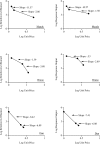A unit price evaluation of severe problem behavior
- PMID: 17970260
- PMCID: PMC1986692
- DOI: 10.1901/jaba.2007.40-463
A unit price evaluation of severe problem behavior
Abstract
We evaluated problem behavior exhibited by 6 individuals with developmental disabilities using the behavioral economic conceptualization of unit price. Descriptive observations were conducted during interactions between the participants and their primary care providers in a clinical laboratory, the participants' homes, or school. Data were recorded on potential reinforcers and problem behavior. After identifying reinforcers for each participant's problem behavior by way of functional analysis, the descriptive data were analyzed retrospectively, using the cost-benefit ratio described by the concept of unit price. Results showed that demand was elastic and produced monotonic response output curves. The results represent an extension of the concept of unit price to severe problem behavior under naturally occurring environmental conditions.
Figures


Similar articles
-
An application of the matching law to severe problem behavior.J Appl Behav Anal. 2002 Spring;35(1):13-27. doi: 10.1901/jaba.2002.35-13. J Appl Behav Anal. 2002. PMID: 11936543 Free PMC article.
-
Descriptive analysis of epileptic seizures and problem behavior in adults with developmental disabilities.Am J Ment Retard. 2005 Sep;110(5):405-12. doi: 10.1352/0895-8017(2005)110[405:DAOESA]2.0.CO;2. Am J Ment Retard. 2005. PMID: 16080778
-
Descriptive analyses of caregiver reprimands.J Appl Behav Anal. 2005 Fall;38(3):373-83. doi: 10.1901/jaba.2005.118-04. J Appl Behav Anal. 2005. PMID: 16270846 Free PMC article.
-
The diagnosis and treatment of individuals with mental illness and developmental disabilities: an overview.Psychiatr Q. 2008 Sep;79(3):157-70. doi: 10.1007/s11126-008-9076-0. Epub 2008 Sep 3. Psychiatr Q. 2008. PMID: 18766442 Review.
-
The token economy for children with intellectual disability and/or autism: a review.Res Dev Disabil. 2009 Mar-Apr;30(2):240-8. doi: 10.1016/j.ridd.2008.04.001. Epub 2008 May 16. Res Dev Disabil. 2009. PMID: 18486442 Review.
Cited by
-
On the applied use of progressive-ratio schedules of reinforcement.J Appl Behav Anal. 2008 Summer;41(2):155-61. doi: 10.1901/jaba.2008.41-155. J Appl Behav Anal. 2008. PMID: 18595280 Free PMC article. Review. No abstract available.
-
Behavioral economics: a tutorial for behavior analysts in practice.Behav Anal Pract. 2013 Spring;6(1):34-54. doi: 10.1007/BF03391790. Behav Anal Pract. 2013. PMID: 25729506 Free PMC article.
-
Consumption and response output as a function of unit price: manipulation of cost and benefit components.J Appl Behav Anal. 2009 Fall;42(3):609-25. doi: 10.1901/jaba.2009.42-609. J Appl Behav Anal. 2009. PMID: 20190922 Free PMC article.
-
Descriptive and experimental analyses of potential precursors to problem behavior.J Appl Behav Anal. 2008 Spring;41(1):83-96. doi: 10.1901/jaba.2008.41-83. J Appl Behav Anal. 2008. PMID: 18468281 Free PMC article.
-
Editorial: Retrospections, Prospections and New Paths for Behavioral Science.Behav Anal. 2017 Dec 4;40(2):291-295. doi: 10.1007/s40614-017-0130-9. eCollection 2017 Nov. Behav Anal. 2017. PMID: 31976971 Free PMC article. No abstract available.
References
-
- Allison J.W. Behavioral economics. New York: Praeger; 1983.
-
- Borrero C.S.W, Vollmer T.R, Borrero J.C, Bourret J. A method for evaluating dimensions of reinforcement during parent-child interactions. Research in Developmental Disabilities. 2005;26:577–592. - PubMed
MeSH terms
LinkOut - more resources
Full Text Sources
Medical

